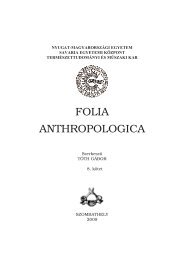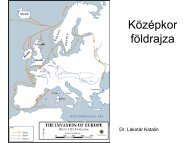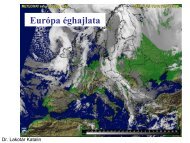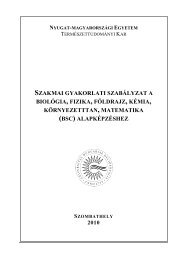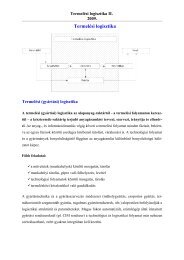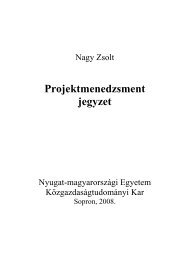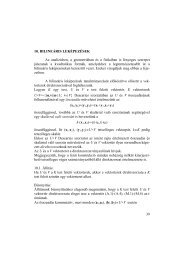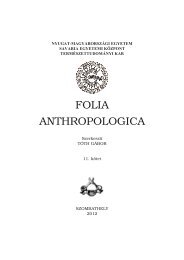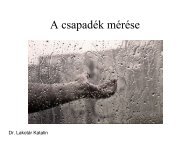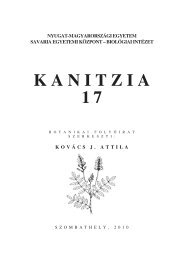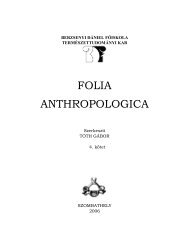Kanitzia 18. - NYME Természettudományi Kar - Nyugat ...
Kanitzia 18. - NYME Természettudományi Kar - Nyugat ...
Kanitzia 18. - NYME Természettudományi Kar - Nyugat ...
Create successful ePaper yourself
Turn your PDF publications into a flip-book with our unique Google optimized e-Paper software.
Pannonia (Hungary) the species were recorded as isolated stand inside of the steppic meadows<br />
and dry grasslands (Stipetum capillatae, Salvio-Festucetum rupicolae ap. SOÓ 1970),<br />
but later from this site the species were extinct (FARKAS (ed.) 1999). In Transylvania (Romania)<br />
the species initially was indicated as a participant of the disturbed dry grasslands,<br />
like the „Agropyron intermedium-Andropogon ischaemum” grassland type (SOÓ 1945),<br />
after that it was considered as of the Agropyretum intermedii plant community (SOÓ 1970)<br />
and later as a component of the steppe like community of Agropyro cristati-Kochietum<br />
prostratae (BĂDĂRĂU et al. 2002). In the Mediterranean area (Spain, Granada) the species<br />
is indicated for arid areas, as a colonizer of abandoned lands and for the disturbed, semirude-ralized<br />
vegetation of the Salsolo-Peganion and Hammado articulatae-Atriplicion<br />
glaucae alliances (COSTA et al. 2000, DOMINGUEZ et al. 2001.<br />
The new sites recorded recently from Transylvania (Romania) require special<br />
coenological attempt, they permit better understandings not only the species biology, but<br />
contribute to elucidate its role in the structure of regional vegetation, landscape history and<br />
extended coenological relations. The general question remains: is the plant K. ceratoides<br />
a decreasingly ancient relict species, or is a relict with increasing/expanding colonize abilities?<br />
The present coenological survey try to clear these points also.<br />
In the followings we will present the syntaxonomical aspects and a short characterisation<br />
of the plant communities with the participation of the species K. ceratoides on<br />
the basis of the site conditions from the Transylvanian Basin (Romania). Using the results<br />
of cluster analysis, three group of sampling plots have been separated, but only the first<br />
group is dominated by K. ceratoides (Agropyro cristati-Krascheninnikovietum ceratoidis<br />
ass. nova).<br />
Syntaxonomic ordering<br />
FESTUCO-BROMETEA Br.-Bl. et R. Tx. ex Klika et Hadač 1944<br />
FESTUCETALIA VALESIACAE Br.-Bl. et R. Tx. ex Br.-Bl. 1949<br />
Artemisio-Kochion Soó (59) 1964<br />
Agropyro cristati-Krascheninnikovietum ceratoidis ass. nova<br />
Festucion rupicolae Soó 1940 corr. 1964<br />
Bothriochloetum ischaemi (Kristiansen 1937) I. Pop 1977<br />
Potentillo arenariae-Stipetum capillatae (Hueck 1931) Libbert 1933<br />
Characterization of the plant communities<br />
1. Agropyro cristati-Krascheninnikovietum ceratoidis ass. nova (Table 1, Fig.1.,2. )<br />
Coenotic stands dominated by Krascheninnikovia ceratoides and co-dominated<br />
by Agropyrum cristatum have been sampled near the localities Vultureni, Poiana Frăţii and<br />
Groapa Rădăii (Table 1, Fig. 1-2). Ecologically, stands of this type occupy very specific<br />
niches and field conditions: abrupt reliefs, open dry places, steep slopes with southerlyfacing<br />
expositions (S to SW, W) and landslides processes, where the sunny warm accumulation<br />
reaches the maximum daytime, followed by strong changes in the night time. Both<br />
two species are well adapted to the very arid niches, to the extreme and rapid changes of<br />
69




